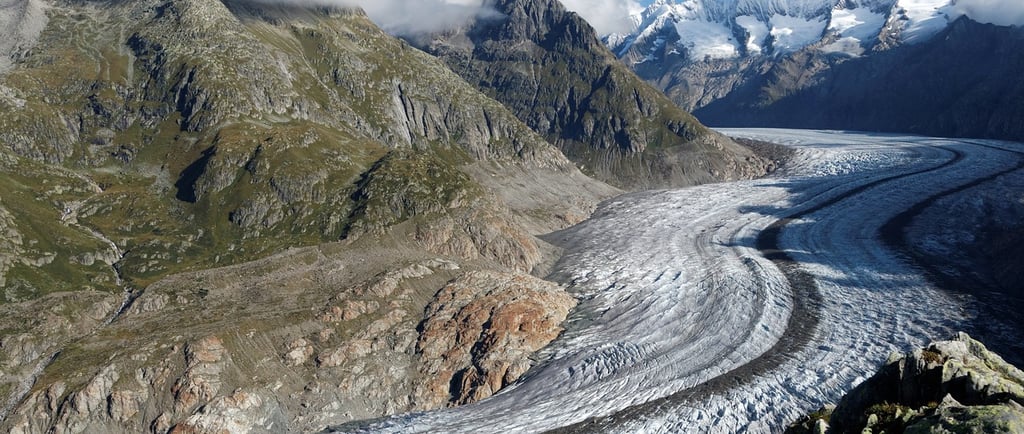The Frozen Journey: How Glaciers Shaped the Land and Human Migration ❄️🌍🏞️
❄️ From carving valleys and moving mountains to creating land bridges, glaciers played a key role in the paths our ancestors followed across the globe. 🌍
HISTORY STORIES
10/18/20243 min read


🌍 Around 10,000 years ago, the world was emerging from the last Ice Age, a time when massive glaciers—giant frozen rivers of ice—covered vast parts of the Earth. These glaciers, which moved slowly like rivers, stretched as far as the eye could see, creeping over mountains 🏔️ and valleys 🌄, changing everything in their path.
A glacier is giant frozen river 🌊 that move so slowly that you might not notice the change from one day to the next. But over time ⏳, their incredible weight presses down on the land, shaping it like a sculptor shaping clay. The rocks 🪨 and dirt beneath are scraped and pushed, creating deep valleys and wide plains.
As the glacier moves, it carries along pieces of the Earth 🌍—giant rocks, stones, and even whole trees 🌳—picked up by the ice and carried for miles. These pieces travel frozen in time, until one day, when the ice melts, they are left behind in new places far from where they started. 🌿
One of the most important times in human history happened when glaciers were still covering large parts of the world. Thousands of years ago, during the Ice Age, the first human inhabitants of North America migrated from Asia. These early people were hunters, following herds of animals 🐘. As the glaciers held vast amounts of water frozen in ice, sea levels were much lower, creating a land bridge between Asia and North America, known as Beringia 🌍. This land bridge allowed humans to cross into new territories, following their food sources across what is now the Bering Strait. When the glaciers began to melt and the sea levels rose again, the land bridge disappeared, but these early nomadic people continued to migrate deeper into North America, shaping the future of human civilization on the continent.
❄️ But how does a glacier move? It might seem strange that something made of ice could move at all. Glaciers move because the pressure of the ice on top causes the ice at the bottom to melt just a little bit. This thin layer of water acts like a slippery surface, allowing the glacier to slide slowly forward, almost like a giant ice skate ⛸️ gliding over the land. The ice is pushed by its own weight, and gravity pulls it down from the high mountains 🏞️.
When the world began to warm up 🌞 around 10,000 years ago, the glaciers started to melt. As they retreated, they left behind the land they had shaped—deep, beautiful valleys and sparkling lakes 💧. And the rocks and boulders they carried? They now sit in strange new places, like old travelers who have finally found a new home 🏞️.
Today, we can still see the marks these glaciers left behind—the U-shaped valleys they carved, the boulders they carried, and the lakes they created. Even though the glaciers moved slowly, their journey changed the world forever.
Migrations Connected to Glaciers which you can propose for research :
Bering Land Bridge Migration 🌍👣
Early humans crossed from Asia to North America during the Ice Age, following herds of animals over a land bridge created by lower sea levels.
Migration into Europe 🏞️❄️
As glaciers in Europe melted, early humans moved into new lands, settling in areas that were once covered by ice.
Peopling of the Americas 🏕️🪨
The first people to enter North and South America migrated south as glaciers retreated, following food and settling new lands.
Migration into Britain 🏴
Glaciers once covered Britain. When they melted, people crossed a land bridge (Doggerland) to settle in Britain, before rising sea levels isolated the island.
Siberian to Arctic Migration 🐺❄️
Early humans migrated through Siberia into the Arctic, adapting to the extreme cold left by retreating glaciers.
Migration to Australia 🌏
Lower sea levels during the Ice Age created land bridges that allowed early humans to migrate from Southeast Asia to Australia.
With this story you can use two Impressionistic charts Chart 22 and Chart 23. These charts visually represent how glaciers move and affect the landscape by carrying debris, creating moraines, and carving out valleys, like U-shaped valleys and fjords.
With Montessori joy,
Vanina 😊

